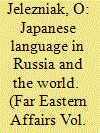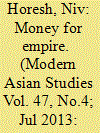| Srl | Item |
| 1 |
ID:
090590


|
|
|
|
|
| Publication |
2009.
|
| Summary/Abstract |
This paper discusses one aspect of learning Japanese as a second language (L2), which is how learners acquire Japanese causative constructions. Causatives are considered to be rather 'marked', because main and sub-events are merged into a single clause, and thus may be more difficult to learn. Yet, ability to use such constructions enhances expressivity and pragmatic-cultural appropriateness, and facilitates comprehension. Cross-sectional oral production data were collected from English-speaking university students of Japanese L2 for this study. Their descriptions of causative eventualities were examined and related to their L2 developmental stage. Results show that the range of choices of construction correlates with learners' stage of development and consequently (i) that there are universal constraints in L2 learning, as proposed by Processability Theory, and (ii) that Japanese L2 development follows a predictable route. Results entail implications for accurate, efficient communication as well as for Japanese L2 learning and teaching.
|
|
|
|
|
|
|
|
|
|
|
|
|
|
|
|
| 2 |
ID:
124534


|
|
|
|
|
| Publication |
2013.
|
| Summary/Abstract |
Japanese Language Teaching (JLT) is well established in Australia but the number of students studying Japanese has been declining. This decline is due to various factors, among them the rise of Mandarin as a language taught in schools and a reduction in government support for JLT. Content and Language Integrated Learning (CLIL), a popular content-based teaching approach developed in Europe, is currently being trialled in Australian primary and secondary schools, and some of these schools have JLT programs. In Europe, CLIL has been particularly successful in improving learners' conversational ability, and the embrace of Japanese CLIL programs in Australia is therefore positive. However, there are factors involved in teaching a particular language in a particular country or region which may influence the success of the approach. In this article I argue that issues related to JLT in Australia, such as the relationship between Australia and Japan, teaching resources, teacher bilingualism and linguistic distance, need to be carefully examined in order to maximise CLIL's potential in a new context.
|
|
|
|
|
|
|
|
|
|
|
|
|
|
|
|
| 3 |
ID:
111856


|
|
|
|
|
| Publication |
2012.
|
| Summary/Abstract |
The article shows the popularity of the Japanese language in Russia and the world relying on a historical and political approach. Besides, the article examines the prospects of the Japanese language becoming one of international communication.
|
|
|
|
|
|
|
|
|
|
|
|
|
|
|
|
| 4 |
ID:
121986


|
|
|
|
|
| Publication |
2013.
|
| Summary/Abstract |
Over the last three decades, a considerable body of English-language academic work has shed much light on Japan's empire-building project in Greater China during the first half of the twentieth century. At the same time, Japanese-language studies of the country's pre-war financial history have also grown in leaps and bounds. Yet, to date, neither body of literature seems to have fully examined what might appear to the naked eye as one of the critical pre-war junctures, where Japanese financial history converged on imperial policy and Chinese nationalist responses thereto.1 This paper will therefore aim to fill part of the gap by examining how the Yokohama Specie Bank, arguably the backbone of Japanese finance in China Proper, was affected by Chinese anti-foreign boycotts throughout the pre-war era (1842-1937).
|
|
|
|
|
|
|
|
|
|
|
|
|
|
|
|